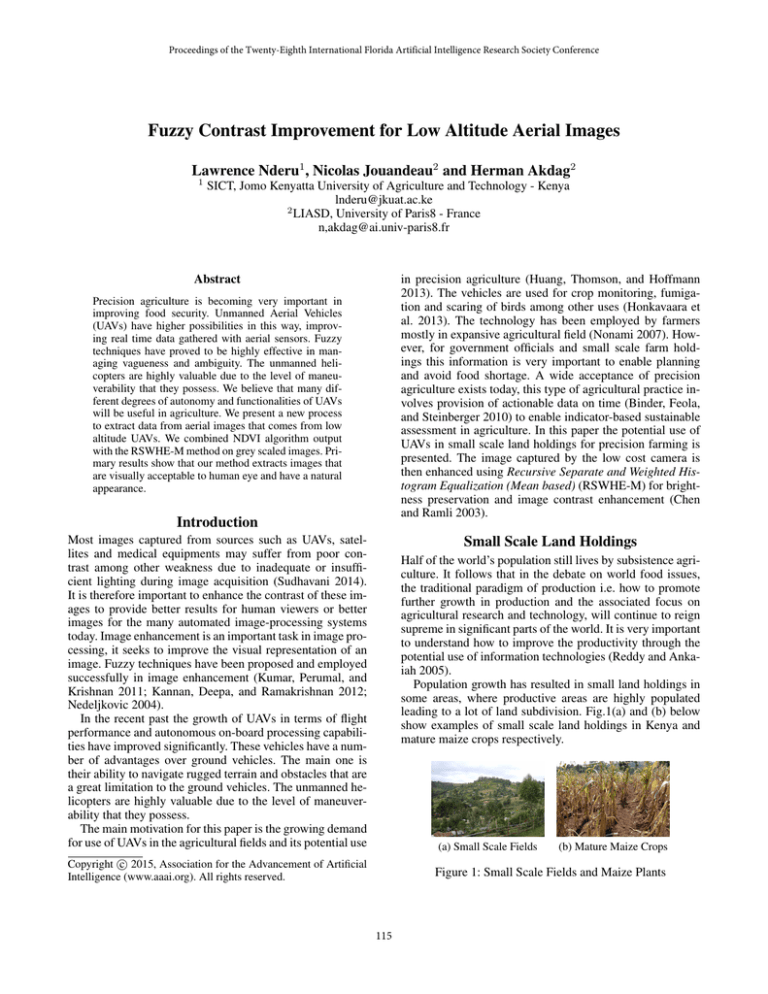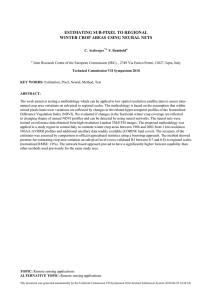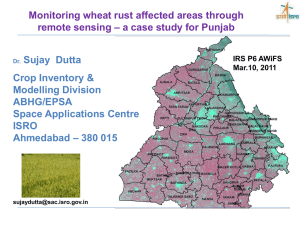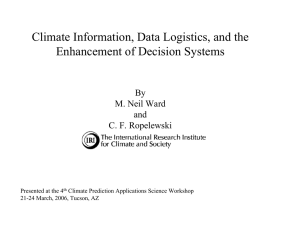
Proceedings of the Twenty-Eighth International Florida Artificial Intelligence Research Society Conference
Fuzzy Contrast Improvement for Low Altitude Aerial Images
Lawrence Nderu1 , Nicolas Jouandeau2 and Herman Akdag2
1
SICT, Jomo Kenyatta University of Agriculture and Technology - Kenya
lnderu@jkuat.ac.ke
2
LIASD, University of Paris8 - France
n,akdag@ai.univ-paris8.fr
Abstract
in precision agriculture (Huang, Thomson, and Hoffmann
2013). The vehicles are used for crop monitoring, fumigation and scaring of birds among other uses (Honkavaara et
al. 2013). The technology has been employed by farmers
mostly in expansive agricultural field (Nonami 2007). However, for government officials and small scale farm holdings this information is very important to enable planning
and avoid food shortage. A wide acceptance of precision
agriculture exists today, this type of agricultural practice involves provision of actionable data on time (Binder, Feola,
and Steinberger 2010) to enable indicator-based sustainable
assessment in agriculture. In this paper the potential use of
UAVs in small scale land holdings for precision farming is
presented. The image captured by the low cost camera is
then enhanced using Recursive Separate and Weighted Histogram Equalization (Mean based) (RSWHE-M) for brightness preservation and image contrast enhancement (Chen
and Ramli 2003).
Precision agriculture is becoming very important in
improving food security. Unmanned Aerial Vehicles
(UAVs) have higher possibilities in this way, improving real time data gathered with aerial sensors. Fuzzy
techniques have proved to be highly effective in managing vagueness and ambiguity. The unmanned helicopters are highly valuable due to the level of maneuverability that they possess. We believe that many different degrees of autonomy and functionalities of UAVs
will be useful in agriculture. We present a new process
to extract data from aerial images that comes from low
altitude UAVs. We combined NDVI algorithm output
with the RSWHE-M method on grey scaled images. Primary results show that our method extracts images that
are visually acceptable to human eye and have a natural
appearance.
Introduction
Most images captured from sources such as UAVs, satellites and medical equipments may suffer from poor contrast among other weakness due to inadequate or insufficient lighting during image acquisition (Sudhavani 2014).
It is therefore important to enhance the contrast of these images to provide better results for human viewers or better
images for the many automated image-processing systems
today. Image enhancement is an important task in image processing, it seeks to improve the visual representation of an
image. Fuzzy techniques have been proposed and employed
successfully in image enhancement (Kumar, Perumal, and
Krishnan 2011; Kannan, Deepa, and Ramakrishnan 2012;
Nedeljkovic 2004).
In the recent past the growth of UAVs in terms of flight
performance and autonomous on-board processing capabilities have improved significantly. These vehicles have a number of advantages over ground vehicles. The main one is
their ability to navigate rugged terrain and obstacles that are
a great limitation to the ground vehicles. The unmanned helicopters are highly valuable due to the level of maneuverability that they possess.
The main motivation for this paper is the growing demand
for use of UAVs in the agricultural fields and its potential use
Small Scale Land Holdings
Half of the world’s population still lives by subsistence agriculture. It follows that in the debate on world food issues,
the traditional paradigm of production i.e. how to promote
further growth in production and the associated focus on
agricultural research and technology, will continue to reign
supreme in significant parts of the world. It is very important
to understand how to improve the productivity through the
potential use of information technologies (Reddy and Ankaiah 2005).
Population growth has resulted in small land holdings in
some areas, where productive areas are highly populated
leading to a lot of land subdivision. Fig.1(a) and (b) below
show examples of small scale land holdings in Kenya and
mature maize crops respectively.
(a) Small Scale Fields
c 2015, Association for the Advancement of Artificial
Copyright Intelligence (www.aaai.org). All rights reserved.
(b) Mature Maize Crops
Figure 1: Small Scale Fields and Maize Plants
115
To make use of UAVs in these kind of environments
(shown in Fig.1(a), a number of factors need to be considered:
1. UAVs in such small land holding areas should target the
crop consultants and not farmers.
2. Provision of regular crop surveys, which is highly possible with the aerial vehicles due to their policy of anywhere
anytime access to the sky, means timely data for the stakeholders.
3. Multicopters which can take off and land anywhere are
the most attractive for such areas.
4. The most important aspect for the users (crop consultants
and farmers) is the images obtained and a decision about
the crop performance.
5. Even within a crop like maize a lot of differences exist
both on the physical properties and the images captured.
Generation of actionable data is not easy. The standard
currently in use for crop surveying is the Normalized Differential Vegetation Index (NDVI) which shows the difference between regular red light reflected from plants and
near-infrared light. A further discussion of this measure is
presented below.
(a) Dead
(c) Healthy
Figure 2: NDVI Values for Dead, Stressed and Healthy
Leaves
others ways of measuring crop health and photosynthetic activity including improvement of NDVI, due to some weakness of the measure (Matsushita et al. 2007; Xu 2006).
Normalized Differential Vegetation Index (NDVI)
Image Acquisition and Data Processing
The main aim of aerial images is to provide users with actionable data for crop classification and mapping, crop forecasting, yield predictions, crop status and condition, weed
detection, disease detection, nutrient deficiency and photosynthetic pigment content (Berni and Zarco-Tejada 2009;
Laliberte et al. 2011; Perumal and Bhaskaran 2010; Yuan
and Bauer 2007). A lot of work has been done on the use
of chlorophyll estimation with the Compact Airborne Spectrographic Imager (Yuan and Bauer 2007), leaf water content measure from the Airborne Visible Infrared Imagining
Spectrometer which have the upper hand in the minimizing
of background effects on traditional indices such as NDVI
index. NDVI was developed by Compton Tucker in 1977
(Govaerts and Verhulst 2010), it is a ratio of near infrared
(NIR) reflectivity minus red reflectivity (VIS) over NIR plus
VIS. Values of NDVI can range from -1.0 to +1.0. Higher
values signify larger differences between the red and near
infrared radiation recorded by the sensor (Berni and ZarcoTejada 2009) a condition associated with highly photo synthetically active vegetation.
N DV I = (RN IR − RRed )/(RN IR + RRed )
(b) Stressed
Different camera models have been discussed that have the
ability to provide output images that have pure NIR, red and
green channels thus true NDVI and NDWI indices can be
calculated (Dworak et al. 2013; Xu 2006). Among a number of considerations for such cameras is the cost, big enterprises such as large farms can use near-infrared photography
by mounting expensive sensors on airplanes and satellites.
After a review of existing literature on existing solutions, a
modified digital camera (infragram) to capture near-infrared
and blue light in the same image, but in different color channels was selected. The single camera technique involves removing the infrared-blocking filter from any digital camera and adding a specific blue filter i.e. NGB filter. Fig. 3
shows the results of modified digital camera and the NDVI
imaging. The tree trunks, brown grass and rocks in Fig. 3
have very low NDVI values since they are not photosynthetic. Healthy plants NDVI values is between 0.1 and 0.9.
Once images are processed an integrative knowledge-based
approach is used. This approach combines imagery (NDVI
output), expert knowledge and geographical data within the
framework of an intelligent recognition system.
(1)
Contrast Enhancement
Fig. 2 illustrates the differences between dead, stressed and
healthy leaves.
The technique uses only red and near infrared data,
two aligned Charge Coupled Device (CCD) chips of the
red and NIR channel are generally used. However, they
are expensive because of the precise optical alignment required (Dworak et al. 2013). Research activities in precision agriculture has taken interest in the design and development of a smart, low-cost cameras (Dworak et al. 2013;
Yuan and Bauer 2007). Researchers have also considered
Contrast enhancement is important in the field of digital image processing for human visual perception and computer
vision (Sharma 2013). A number of methods have been
developed for contrast enhancement. The choice of an enhancement method largely depends on the objectives of the
resultant image(s). Histogram equalization is one of the most
popular method, it distributes the pixels intensity over the
full intensity range (Sharma 2013). Several variations of histogram equalization methods have been proposed (Sharma
116
Where, pmax and pmin are maximum and minimum
probability value from original histogram respectively. αi
is an accumulative probability value for ith sub-histogram
Hir (X). αi is calculated for each sub-histogram.
αi =
Ui
X
p(Xk )
(3)
k=Li
β is a value which is ≤ 0. The degree of mean brightness
and contrast enhancement of output image can be controlled
by adjusting β. The eventual use of this image is to show
the crop consultants and also compare it with the standard
dataset created with expert’s input. When this comparison
is made a decision on how well the plants are doing can be
made. Fig. 4 shows the resultant gray scale image and the
resultant histogram.
(a) Normal Color Photo (RGB)
Figure 4: Original Gray Scale Image (Normal Color Photo
and NDVI Images)
(b) NDVI Image
Figure 3: Normal Color Photo and NDVI Images
2013), and after a comparative study of images captured by
UAVs and enhanced using histogram equalization methods
it was found that RSWHE-M offers better brightness preservation, better contrast enhancement and better structure similarity index as compared to other methods.
Figure 5: Resultant Histogram (Normal Color Photo and
NDVI Images)
The image captured by the modified digital camera and
enhanced using RSWHE-M, uses expert knowledge in order
to overcome the difficulties in crop state recognition. During this process we have to be especially careful that the
processed image is not distinctly different from the original
image, which could make the identification process worthless. We have processed some initial NDVI images using
the above approach, Table 1 below shows the initial results.
The performance is then evaluated on the basis of the following widely-used metrics absolute mean brightness error (AMBE), structure similarity index measure (SSIM) and
peak signal to noise ratio(PSNR). The richness of the details
in the output image is measured using the entropy.
A UAVs solution for precision agriculture must collect
usable data to improve yields and overall profitability. The
most important factors for sustainable UAVs in agriculture
noted are: the platform, communication system, sensors,
data processing and integration, legal and ethical issues and
operation. These components must work together for the
successful implementation of UAVs solution in small scale
Recursive Separate and Weighted Histogram
Equalization (Mean based)-(RSWHE-M)
To enhance and preserve the image brightness RSWHE-M
is used. The technique consists of three modules (Jayaram,
Narayana, and Vetrivel 2011).
1. Histogram segmentation
2. Histogram weighting
3. Histogram equalization module
After the histogram segmentation module that generates 2r
sub-histograms, i.e. Hir , 1 ≤ i ≤ 2r the recursion level r is
known. The histogram weighting module specially modifies
the probability density function of each sub histogram using the normalized power law function (Sharma 2013). For
each sub-histogramHir , corresponding original PDF p(Xk ,
the weighted PDF PW (xk , the probability density is described in (2).
pw (Xk = pmax (
p(Xk − pmin αi
) +β, (Li ≤ k ≤ Ui ) (2)
pmax − pmin
117
Table 1: Initial Results
NDVI IMAGE
IMAGE 1
IMAGE 2
IMAGE 3
IMAGE 4
AMBE
2.57
1.70
5.45
1.89
SSIM
0.99
0.98
0.88
0.97
PSNR
35.18
30.05
23.99
32.29
Huang, Y.; Thomson, S.; and Hoffmann, W. 2013. Development and prospect of unmanned aerial vehicle technologies
for agricultural production management. Agricultural and
Biological Engineering 6(3):1–10.
Jayaram, B.; Narayana, K.; and Vetrivel, V. 2011. Fuzzy
Inference System based Contrast Enhancement. Proc. 7th
Conf. Eur. Soc. Fuzzy Log. Technol.
Kannan, P.; Deepa, S.; and Ramakrishnan, R. 2012. Contrast
Enhancement of Sports Images Using Two Comparative Approaches. Am. J. Intell. Syst. 2(6):141–147.
Kumar, T.; Perumal, S.; and Krishnan, N. 2011. Fuzzy
Based Contrast Stretching for Medical Image Enhancement.
Comput. Spec. Issue Fuzzy 6956(July):233–236.
Laliberte, A. S.; Goforth, M. a.; Steele, C. M.; and Rango,
A. 2011. Multispectral Remote Sensing from Unmanned
Aircraft: Image Processing Workflows and Applications for
Rangeland Environments. Remote Sens. 3(12):2529–2551.
Matsushita, B.; Yang, W.; Chen, J.; Onda, Y.; and Qiu, G.
2007. Sensitivity of the Enhanced Vegetation Index (EVI)
and Normalized Difference Vegetation Index (NDVI) to Topographic Effects: A Case Study in High-density Cypress
Forest. Sensors 7(11):2636–2651.
Nedeljkovic, I. 2004. Image classification based on fuzzy
logic. Int. Arch. Photogramm. 1–6.
Nonami, K. 2007. Prospect and Recent Research & Development for Civil Use Autonomous Unmanned Aircraft as
UAV and MAV. J. Syst. Des. Dyn. 1(2):120–128.
Perumal, K., and Bhaskaran, R. 2010. Supervised classification performance of multispectral images. arXiv Prepr.
arXiv1002.4046 2(2):124–129.
Reddy, P., and Ankaiah, R. 2005. A framework of information technology-based agriculture information dissemination system to improve crop productivity. Curr. Sci.
Sharma, O. P. Y. P. S. 2013. A Comparative Study of Histogram Equalization Based Image Enhancement Techniques
for Brightness Preservation and Contrast. 4(5):11–25.
Sudhavani, G. 2014. Comparison of Fuzzy Contrast Enhancement Techniques. Computer Applications 95(22):26–
31.
Xu, H. 2006. Modification of normalised difference water
index (NDWI) to enhance open water features in remotely
sensed imagery. Int. J. Remote Sens. 27(14):3025–3033.
Yuan, F., and Bauer, M. E. 2007. Comparison of impervious surface area and normalized difference vegetation index
as indicators of surface urban heat island effects in Landsat
imagery. Remote Sens. Environ. 106(3):375–386.
ENTROPY
3.98
6.55
5.88
5.60
land holdings. The most challenging part is the collection
of data. As shown in Table 1. a good balance is needed to
be able to put this images together and generate one homogeneous data set. A number of factors affect the output image captured by the drones and a number of properties for
the images needs to be established before and after enhancement.
Conclusion
In this paper we have proposed the use of RSWHE-M on
images captured by a low cost camera. The aim is to enhance contrast for human visual perception and computer
vision. The normalized differential vegetation index is used
to measure the health status of plants. The fuzzy methods offer a powerful framework for use of expert knowledge in the
processing of data and presentation of the same to the crop
consultants and farmers. Future work includes creating an
application with the capability to compare this images and
give feedback to farmers on the crop status.
References
Berni, J., and Zarco-Tejada, P. 2009. Thermal and narrowband multispectral remote sensing for vegetation monitoring
from an unmanned aerial vehicle. IEEE Trans. on Remote
Sensing 1–17.
Binder, C. R.; Feola, G.; and Steinberger, J. K. 2010. Considering the normative, systemic and procedural dimensions
in indicator-based sustainability assessments in agriculture.
Environ. Impact Assess. Rev. 30(2):71–81.
Chen, S., and Ramli, A. 2003. Contrast enhancement using
recursive mean-separate histogram equalization for scalable
brightness preservation. IEEE Trans. on Consum. Electron.
49(4):1301–1309.
Dworak, V.; Selbeck, J.; Dammer, K.-H.; Hoffmann, M.;
Zarezadeh, A. A.; and Bobda, C. 2013. Strategy for the
development of a smart NDVI camera system for outdoor
plant detection and agricultural embedded systems. Sensors
(Basel). 13(2):1523–38.
Govaerts, B., and Verhulst, N. 2010. The normalized difference vegetation index (NDVI) Greenseeker (TM) handheld sensor: toward the integrated evaluation of crop management. Part A.
Honkavaara, E.; Saari, H.; Kaivosoja, J.; Pölönen, I.; Hakala,
T.; Litkey, P.; Mäkynen, J.; and Pesonen, L. 2013. Processing and Assessment of Spectrometric, Stereoscopic Imagery Collected Using a Lightweight UAV Spectral Camera
for Precision Agriculture. Remote Sens. 5(10):5006–5039.
118




